Wildflowers, Grasses and Other Nonwoody Plants
Media

Species Types
Scientific Name
Ratibida pinnata
Description
The “disk” of gray-headed coneflower is an inch-long, round knob. It starts off gray, but as the disk florets open and bloom, it turns brown. It grows almost statewide in prairies, glades, pastures, fencerows, and roadsides.
Media

Species Types
Scientific Name
Lobelia spicata
Description
A single-stalked perennial with white or pale blue flowers all along the top portion of the stem, spiked lobelia is most common in sunny or grassy habitats like prairies, old fields, forest openings, and glades.
Media
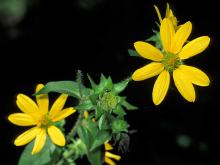
Species Types
Scientific Name
Silphium asteriscus
Description
Starry rosinweed is a relatively short rosinweed that grows scattered mostly in the southern half of Missouri. It blooms May through September.
Media

Species Types
Scientific Name
Veronicastrum virginicum
Description
Culver’s root is a tall, graceful perennial with flower clusters that look like candelabras. The white flowers are packed together in slender, brushlike spikes. The leaves are in whorls, well-spaced along the stalk.
Media
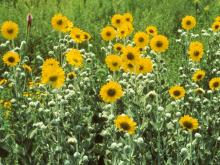
Species Types
Scientific Name
Helianthus spp.
Description
Most people recognize sunflowers when they see them, with their bright yellow ray flowers and rather flattened center of dark disk flowers. There are 16 species of Helianthus in Missouri.
Media

Species Types
Scientific Name
Symphyotrichum spp. (formerly Aster spp.)
Description
Missouri has 24 species of New World asters in genus Symphyotrichum. Most have purple or white ray flowers and yellow disk flowers that turn reddish over time. Most bloom in late summer and fall.
Media

Species Types
Scientific Name
Vernonia missurica
Description
Missouri ironweed is one of Missouri’s five species of ironweeds. Most common in the eastern half of the state, it is a hairy ironweed with a relatively large number of florets per flowerhead.
Media
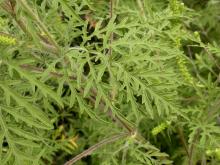
Species Types
Scientific Name
Ambrosia artemisiifolia
Description
Common ragweed is instantly recognizable by its ornate, 2–3 times pinnately lobed, hairy leaves. You’ve probably seen it many times and wondered what it was.
Media
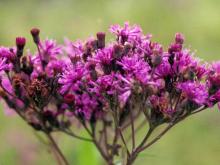
Species Types
Scientific Name
Vernonia spp.
Description
Five species of ironweeds live in Missouri. Starting in the middle of summer, they bear showy clusters of magenta or purple flowerheads at the branching tops of upright stalks.
Media
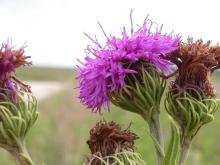
Species Types
Scientific Name
Vernonia arkansana
Description
Curlytop ironweed is one of Missouri’s five species of ironweeds. It’s easy to identify because of its tapering, curling, threadlike involucral bracts. Also, it is usually a smooth, hairless plant.
See Also
About Wildflowers, Grasses and Other Nonwoody Plants in Missouri
A very simple way of thinking about the green world is to divide the vascular plants into two groups: woody and nonwoody (or herbaceous). But this is an artificial division; many plant families include some species that are woody and some that are not. The diversity of nonwoody vascular plants is staggering! Think of all the ferns, grasses, sedges, lilies, peas, sunflowers, nightshades, milkweeds, mustards, mints, and mallows — weeds and wildflowers — and many more!





















